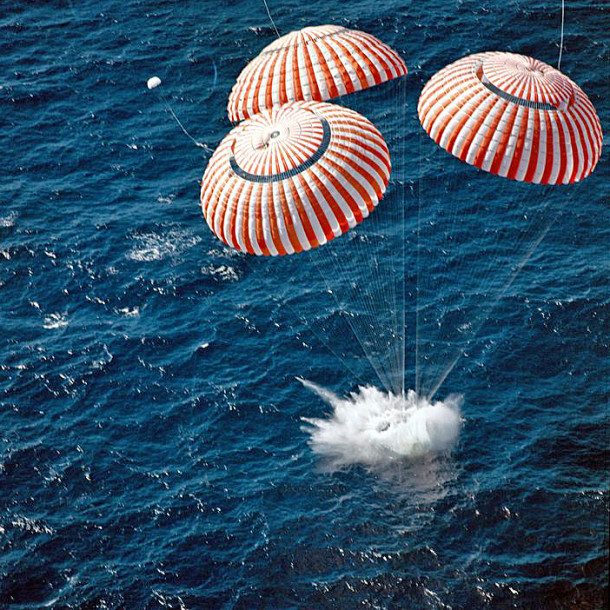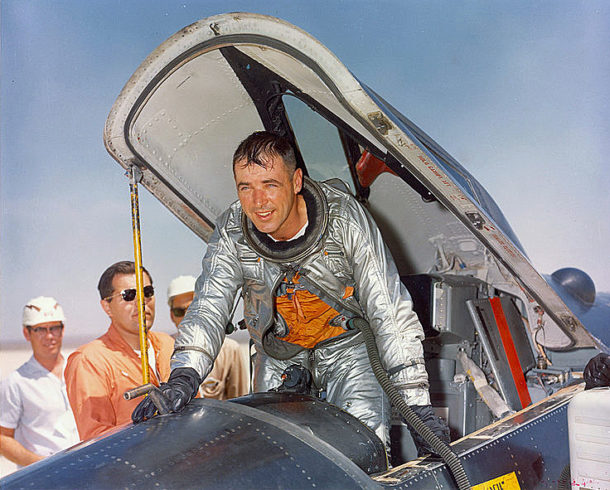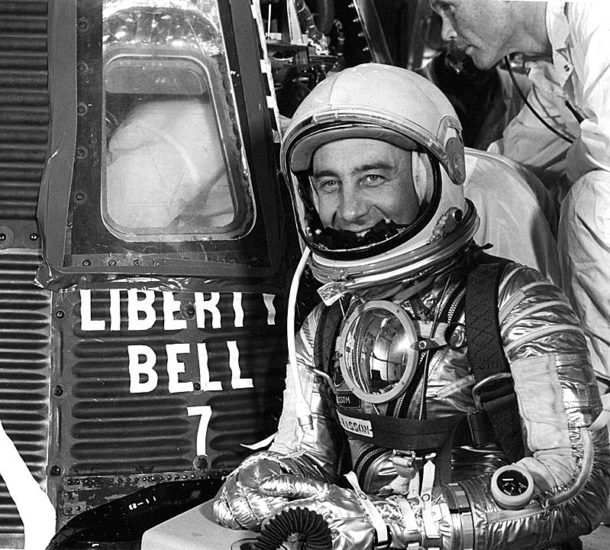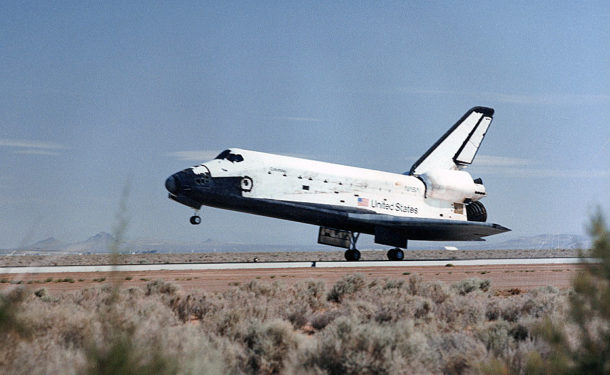
Forty-nine years ago today, Apollo 11 astronauts Neil A. Armstrong, Edwin E. Aldrin, Jr., and Michael Collins returned safely to the Earth to bring to a close the first space mission to land men on the lunar surface. With their safe return, President John F. Kennedy’s inspired national goal of landing men on the Moon and bringing them safely home before the end of the 1960’s was successfully accomplished.
The crew of Apollo 11 and their celestial chariot, Columbia, splashed-down in the Pacific Ocean at a point 812 nautical southwest of Hawaii. The epic journey to the Moon and back covered 952,700 nautical miles. Mission total elapsed time was 195 hours, 18 minutes, and 35 seconds.
Following splashdown, the Apollo 11 astronauts and their Command Module Columbia were brought aboard the USS Hornet (CV-12). Concerned that they would infect Earthlings with lunar pathogens, NASA quarantined the astronauts in the Mobile Quarantine Facility (MQF), which was a converted vacation trailer.
The Hornet steamed for Hawaii and transferred the MQF for airlift to Ellington Air Force Base, Texas. Following landing, the MQF and its heroic occupants were transported to the Johnson Spacecraft Center (MSC) in Houston, Texas. Once there, the astronauts and several medical staff were transferred from the MQF to more substantial accommodations known as the Lunar Receiving Laboratory (LRL).
Combined stay time in the MQF and LRL was 21 days. During their forced confinement, Armstrong, Aldrin, and Collins debriefed the Apollo 11 mission, rested, and mused about their unforgettable experiences at the Moon.
The Apollo 11 astronauts were released from the LRL on Thursday, 13 August 1969, having never contracted nor transmitted a lunar disease.
Parenthetically, Apollo 11 brought the first geologic samples from the Moon back to Earth. Roughly 48 pounds of lunar rock samples were collected. Two primary types of rocks, basalts and breccias, were found at the Sea of Tranquility landing site. Subsequent analyses indicated that these samples neither contained water nor provided evidence for living organisms at any time in the history of the Moon.

Fifty-six years ago to the day, USAF Major Robert M. White flew the North American X-15 hypersonic research aircraft to a record altitude of 314,750 feet (51.8 nautical miles). In doing so, he became the first X-15 pilot to be awarded USAF Astronaut Wings.
The North American X-15 was the first manned hypersonic aircraft. It was designed, engineered, constructed and first flown in the 1950′s. As originally conceived, the X-15 was designed to reach 4,000 mph (Mach 6) and 250,000 feet. Before its flight test career was over, the type would meet and exceed both performance goals.
North American built a trio of X-15 airframes; Ship No. 1 (S/N 56-6670), Ship No. 2 (56-6671) and Ship No. 3 (56-6672). The X-15 measured 50 feet in length, had a wing span of 22 feet and a GTOW of 33,000 lbs. Ship No. 2 would later be modified to the X-15A-2 enhanced performance configuration. The X-15A-2 had a length of 52.5 feet and a GTOW of around 56,000 lbs.
The Reaction Motors XLR-99 rocket engine powered the X-15. The small, but mighty XLR-99 generated 57,000 pounds of sea level thrust at full-throttle. It weighed only 910 pounds. The XLR-99 used anhydrous ammonia and LOX as propellants. Burn time varied between 83 seconds for the stock X-15 and about 150 seconds for the X-15A-2.
The X-15 was carried to drop conditions (typically Mach 0.8 at 42,000 feet) by a B-52 mothership. A pair of aircraft were used for this purpose; a B-52A (S/N 52-003) and a B-52B (S/N 52-008). Once dropped from the mothership, the X-15 pilot lit the XLR-99 to accelerate the aircraft. The X-15A-2 also carried a pair of drop tanks which provided propellants for a longer burn time than was possible with the stock X-15 flight.
The X-15 employed both aerodynamic and reaction flight controls. The latter were required to maintain vehicle attitude in space-equivalent flight. The X-15 pilot wore a full-pressure suit in consequence of the aircraft’s extreme altitude capability. The typical X-15 drop-to-landing flight duration was on the order of 10 minutes. All X-15 landings were performed deadstick.
On Tuesday, 17 July 1962, Bob White flew his 15th X-15 mission. The X-15 and White had already become the first aircraft-pilot duo to hit Mach 4, 5 and 6. On this particular day, White was at the controls of X-15 Ship No. 3. It was the 62nd flight research mission of the X-15 Program with a target maximum altitude of 282,000 feet.
At 09:31:10 UTC, X-15 Ship No. 3 was launched from the B-52B mothership commanded by USAF Captain Jack Allavie. White lit the XLR-99 and pulled into a steep climb. His hypersonic steed rapidly gained altitude. Burnout of the XLR-99 occurred 82 seconds after ignition; 2.0 seconds longer than planned. At this point, White was traveling at 3,832 mph or Mach 5.45. Following an uneventful climb to apogee and a expertly-flown reentry, White touched-down safely on Rogers Dry Lake at 09:41:30 UTC. His reaction to the entire experience was succinctly expressed when he exclaimed, “Boy, that was a ride!”
The extra impulse provided by the longer-than-planned burn of the XLR-99 rocket engine drove White’s X-15 more than 32,000 feet higher than planned. The resulting apogee of 314,750 feet established a still-standing FAI world altitude record for piloted aircraft. The occasion also marked the first time that the X-15 flew higher than 300,000 feet. For flying beyond 50 statute miles (264,000 feet), Bob White received USAF Astronaut Wings; the first X-15 pilot to be awarded such.
Bob White piloted the X-15 a total of sixteen (16) times. He was one (1) of only twelve (12) men to fly the aircraft. White left X-15 Program and Edwards AFB in 1963. He went on to serve his country in numerous capacities as a member of the Air Force including flying 70 combat missions in Viet Nam. He returned to Edwards AFB as AFFTC Commander in August of 1970.
Major General Robert M. White retired from the United States Air Force in 1981. During his period of military service, he received numerous decorations and awards including the Air Force Cross, Distinguished Service Medal, Silver Star with three oak leaf clusters, Legion of Merit, Distinguished Flying Cross with four oak leaf clusters, Bronze Star Medal, and Air Medal with 16 oak leaf clusters.
Bob White was a true American hero. He was one of those heroes who neither sought nor received much notoreity for his accomplishments. He served his country and the aviation profession well. Bob White’s final flight occurred on Wednesday, 17 March 2010. He was 85 years of age.

Fifty-seven years ago this month, Mercury Seven Astronaut Vigil I. “Gus” Grissom, Jr. became the second American to go into space. Grissom’s suborbital mission was flown aboard a Mercury space capsule that he named Liberty Bell 7.
The United States first manned space mission was flown on Friday, 05 May 1961. On that day, NASA Astronaut Alan B. Shepard, Jr. flew a 15-minute suborbital mission down the Eastern Test Range in his Freedom 7 Mercury spacecraft. Known as Mercury-Redstone 3, Shepard’s mission was entirely successful and served to ignite the American public’s interest in manned spaceflight.
Shepard was boosted into space via a single stage Redstone rocket. This vehicle was originally designed as an Intermediate-Range ballistic Missile (IRBM) by the United States Army. It was man-rated (that is, made safer and more reliable) by NASA for the Mercury suborbital mission. A descendant of the German V-2 missile, the Redstone produced 78,000 lbs of sea level thrust.
Shepard’s suborbital trajectory resulted in an apogee of 101 nautical miles (nm). With a burnout velocity of 7,541 ft/sec, Freedom 7 splashed-down in the Atlantic Ocean 263 nm downrange of its LC-5 launch site at Cape Canaveral, Florida. Shepard endured a maximum deceleration of 11 g’s during the reentry phase of the flight.
Mercury-Redstone 4 was intended as a second and confirming test of the Mercury spacecraft’s space-worthiness. If successful, this mission would clear the way for pursuit and achievement of the Mercury Program’s true goal which was Earth-orbital flight. All of this rested on the shoulders of Gus Grissom as he prepared to be blasted into space.
Grissom’s Liberty Bell 7 spacecraft was a better ship than Shepard’s steed from several standpoints. Liberty Bell 7 was configured with a large centerline window rather than the two small viewing ports featured on Freedom 7. The vehicle’s manual flight controls included a new rate stabilization system. Grissom’s spacecraft also incorporated a new explosive hatch that made for easier release of this key piece of hardware.
Mercury-Redstone 4 (MR-4) was launched from LC-5 at Cape Canaveral on Friday, 21 July 1961. Lift-off time was 12:20:36 UTC. From a trajectory standpoint, Grissom’s flight was virtually the same as Shepard’s. He found the manual 3-axis flight controls to be rather sluggish. Spacecraft control was much improved when the new rate stabilization system was switched-on. The time for retro-fire came quickly. Grissom invoked the retro-fire sequence and Liberty Bell 7 headed back to Earth.
Liberty Bell 7’s reentry into the Earth’s atmosphere was conducted in a successful manner. The drogue came out at 21,000 feet to stabilize the spacecraft. Main parachute deployed occurred at 12,300 feet. With a touchdown velocity of 28 ft/sec, Grissom’s spacecraft splashed-down in the Atlantic Ocean 15 minutes and 32 seconds after lift-off. America now had both a second spaceman and a second successful space mission under its belt.
Following splashdown, Grissom logged final switch settings in the spacecraft, stowed equipment and prepared for recovery as several Marine helicopters hovered nearby. As he did so, the craft’s new explosive hatch suddenly blew for no apparent reason. Water started to fill the cockpit and the surprised astronaut exited the spacecraft as quickly as possible.
Grissom found himself outside his psacecraft and in the water. He was horrfied to see that Liberty Bell 7 was in imminent peril of sinking. The primary helicopter made a valiant effort to hoist the spacecraft out of the water, but the load was too much for it. Faced with losing his vehicle and crew, the pilot elected to release Liberty Bell 7 and abandon it to a watery grave.
Meanwhile, Grissom struggled just to stay afloat in the churning ocean. The prop blast from the recovery helicopters made the going even tougher. Finally, Grissom was able to retrieve and get himself into a recovery sling provided by one of the helicopters. He was hoisted aboard and subsequently delivered safely to the USS Randolph.
In the aftermath of Mercury-Redstone 4, accusations swirled around Grissom that he had either intentionally or accidently hit the detonation plunger that activated the explosive hatch. Always the experts on everything, especially those things of which they have little comprehension, the root weevils of the press insinuated that Grissom must have panicked. Grissom steadfastly asserted to the day that he passed from this earthly scene that he did no such thing.
Liberty Bell 7 rested at a depth of 15,000 feet below the surface of the Atlantic Ocean until it was recovered by a private enterprise on Tuesday, 20 July 1999; a day short of the 38th anniversary of Gus Grissom’s MR-4 flight. The beneficiary of a major restoration effort, Liberty Bell 7 is now on display at the Kansas Cosmosphere and Space Center. The spacecraft’s explosive hatch was never found.
As for Gus Grissom, ultimate vindication of his character and competence came in the form of his being named by NASA as Commander for the first flights of Gemini and Apollo. Indeed, Grissom and rookie astronaut John W. Young successfully made the first manned Gemini flight in March of 1965 during Gemini-Titan 3. Later, Grissom, Edward H. White II and Roger B. Chaffee trained as the crew of Apollo 1 which was slated to fly in early 1967. History records that their lives were cut short in the tragic and infamous Apollo 1 Spacecraft Fire of Friday, 27 January 1967.

Thirty-six years ago today, the Space Shuttle Columbia landed at Edwards Air Force Base to successfully conclude the fourth orbital mission of the Space Transportation System. Columbia’s return to earth added a special and patriotic touch to the celebration of our nation’s 206th birthday.
STS-4 was NASA’s fourth Space Shuttle mission in the first fourteen months of Shuttle orbital flight operations. The two-man crew consisted of Commander Thomas K. Mattingly, Jr. and Pilot Henry W. Hartsfield who were both making their first Shuttle orbital mission. STS-4 marked the last time that a Shuttle would fly with a crew of just two.
STS-4 was launched from Cape Canaveral’s LC-39A on Sunday, 27 June 1982. Lift-off was exactly on-time at 15:00:00 UTC. This mission stands as the first occasion in which a Space Shuttle launch would occur precisely on-time. The Columbia orbiter weighed a hefty 241,664 lbs at launch.
Mattingly and Hartsfield spent a little over seven (7) days orbiting the Earth in Columbia. The orbiter’s cargo consisted of the first Getaway Special payloads and a classified US Air Force payload of two missile launch-detection systems. In addition, a Continuous Flow Electrophoresis System (CFES) and the Mono-Disperse Latex Reactor (MLR) were flown for a second time.
The Columbia crew conducted a lightning survey using manual cameras and several medical experiments. Mattingly and Hartsfield also maneuvered the Induced Environment Contamination Monitor (IECM) using the Orbiter’s Remote Manipulator System (RMS). The IECM was used to obtain information on gases and particles released by Columbia in flight.
On Sunday, 04 July 1982, retro-fire of the Orbital Maneuvering System (OMS) engines started Columbia on its way back to Earth. Touchdown occurred on Edwards Runway 22 at 16:09:31 UTC. This landing marked the first time that an Orbiter landed on a concrete runway. (All three previous missions had landed on Rogers Dry Lake at Edwards.) Columbia made 112 complete orbits and traveled 2,537,196 nautical miles during STS-4.
The Space Shuttle was optimistically declared “operational” with the successful conduct of the first four (4) shuttle missions. President Ronald Reagan and First Lady Nancy Reagan even greeted the returning STS-4 flight crew on the tarmac.
However, as space history has taught us, manned spaceflight still comes with a level of risk and danger that exceeds that of military and commercial aircraft operations. Despite its unparalleled accomplishments and enduring legacy, the Space Shuttle was never operational in the true and desired sense.




